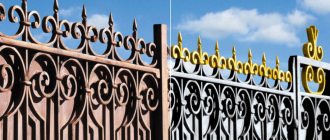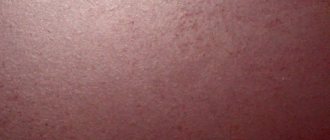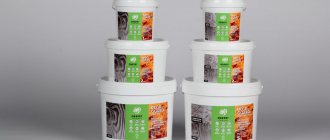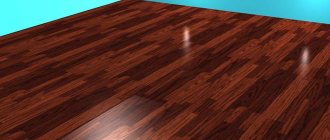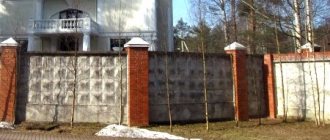A wooden fence can decorate a site; the natural material is particularly attractive, but cannot withstand natural phenomena for long. For this reason, in order for the fence to stand for a long time, additional surface protection is required; various means are used for this purpose, including painting. The rules for choosing what to paint a wooden fence and the rules for carrying out the process will be discussed in detail below.
The best way to paint a wooden fence
Fences and picket fences made of wood are an excellent decoration and addition to the exterior of any home and site. But do not forget that these advantages of decorative wooden fences will depend on who carried out the installation, as well as on the quality of the materials used and their shapes.
Multi-colored wooden picket fence
Using ordinary paint as the main coating of a fence on an unprepared surface, you can encounter unpleasant consequences, such as loss of color on the wood surface, as well as peeling.
Each of us wants to paint as little as possible due to the high price, but at the same time we count on the long-term service of the already applied coating layer. But to achieve a similar result, it is worth carrying out thorough preparation before painting the fence.
Simple painting of a wooden fence in one color
General recommendations for painting a fence
The process of applying paint to wooden boards of a fencing structure
The installed fence at the dacha or around the house needs to be painted as soon as possible. Without proper treatment, the wood begins to rot and collapse. First, the wood is treated with impregnation. When it dries, apply a primer and then two coats of paint.
There are two ways to paint a fence – with a paint brush and a primer roller. When using a brush, more paint is consumed, but the quality of the work will be better. If you paint with a roller, less paint will be used, but there may still be places that will then have to be painted over with a brush.
Before painting, it is recommended to clean the fence from dust and dirt. If this is not done, flaws may remain after work. All cleaning, impregnation and painting work is carried out only in dry, warm weather.
In order for a fence to serve for a long time and maintain an attractive appearance, it needs care. “Health” procedures for him should be carried out at least once every two years. Then its service life will increase by 2-3 times.
Is a fence just a fence or the face of a house?
The main purpose of the fence is to delimit the local area from the street. The fence is an obstacle for stray animals and other uninvited guests. It provides privacy and makes the courtyard near the house cozy. A fenced space is safer for children living in the house, as it eliminates the risk of them going out onto the street or roadway.
Article on the topic: Where does the Lancer 9 air intake come from?
In addition to protection, any fence also serves a decorative function. It appears before the eyes before the main buildings. This should be taken into account when choosing material for fence construction. Often preference is given to natural materials, such as wood. It fits perfectly into the surrounding landscape and is suitable for most materials that are used for finishing houses and outbuildings.
Preparing the picket fence surface for painting
Before starting any painting work, the surface to be painted undergoes thorough preparation. In the case of a fence, it is as follows:
- removing the old layer of paint;
- removal of contaminants ingrained into the structure;
- sealing any structural defects, such as cracks, grooves, bumps, etc., for which wood putty is used;
- grinding and polishing;
- surface leveling;
- if necessary, replace picket fences that cannot be used due to significant mechanical damage.
Removing the old paint layer
Removing contaminants ingrained into the structure
Repairing any structural defects such as cracks, recesses, bumps, etc.
Sanding and polishing
Leveling the surface
Replacement of picket fences that cannot be used due to significant mechanical damage
Quality preparation is very important. Not only the quality of the coating, but also its protective and decorative functions directly depends on it.
It is recommended to choose warm and sunny weather for the dyeing process. This should be done even in cases where coloring compounds are used, the instructions for which indicate the possibility of use in damp and cold weather.
Cost of a metal picket fence
The price of a picket fence made of steel profile directly depends on its external parameters: the number of stiffeners and height. The composition and quantity of the applied polymer coating also affects the price. How to paint metal picket fence
For example, a picket fence with one-sided coating will cost less than a product coated with polymer on both sides.
Depending on the characteristics, the price of one meter of product can range from 50 to 80 rubles. Knowing the perimeter of the fenced area and the expected gap between the pickets, you can easily calculate the amount of materials required.
With a profile width of 100 mm, it is recommended to install 7 pickets per 1 linear meter.
Some manufacturers supply ready-made sections of metal picket fence.
The total cost of the fence depends on the technology of its installation. Let's consider how much it will cost approximately for one linear meter of a fence using products from the “Euro picket fence” series with fastening on two metal logs, the gap between the pickets is 2 cm, support posts are 60 x 60 mm.
This amount will need to be spent if the supporting fence posts are installed by simply driving them into the ground with preliminary drilling of a hole. If the supports are secured using the butting (or backfilling) method, the cost of the fence will be higher.
When concreting the pillars, the overall price of the fence also increases.
The most expensive would be a fence made of metal picket fence on a strip foundation with the installation of supporting brick or stone pillars. It is assembled from ready-made metal sections.
Article on the topic: What kind of reinforcement for a fence foundation
The best way to paint an old fence | Home Guides
When Tom Sawyer had to paint his Aunt Polly's picket fence, he cleverly enlisted his friends to take on the tedious job of brushing on the paint. You may not be lucky enough to have such a trusting talent pool, but with the benefits of modern technology, you won't have to spend a day cleaning your fence either. Using an airless sprayer takes less time than brushing your teeth. However, if you don't want to paint the bushes and grass along with the fence, you'll have to spend some of the time you save on protecting them.
Prepare the fence by scraping off any old peeling paint with a scraper. If the fence is very dirty, wash it with a power washer, wait until it dries, and then brush off any remaining dirt with an old, stiff brush.
Replace any rotted boards with new ones. If any of the rails are sagging, pry up the boards attached to them, replace them, and screw the boards back on, using a level to level them. Repair split boards by gluing the broken piece with epoxy glue and gluing it back to the board.
Tie bushes and flowers around the fence with twine and cover them with plastic wrap. Place the plastic on the ground under the fence. If you're painting a long fence, work in sections so you don't cover the plants or deprive them of air for long periods of time.
Prime all bare wood with a stain-resistant primer. In most cases, you only need to prime the old fence, and you can do it quickly with a brush. Wait an hour or two for the primer to dry.
Fill the spray cup with paint if you are using a hand gun. If you are using a removable unit with a freestanding pump, insert the pump suction tube into the paint can. You don't need to thin the paint for the sprayer to handle it.
Start on the back side of the fence. Spray the rails in a horizontal motion, then switch to a vertical motion to spray the pickets on that side of the fence. Just spray your faces; you can paint the edges when you spray the other side of the fence.
Spray as far as you can so the paint doesn't get onto any uncovered plants or grass, then move to the front of the fence and paint that side. Using a vertical motion, apply the paint to the front and sides of the boards and the face of the rails.
Move the plastic to another section of the fence and continue painting until the fence is complete. Let the paint dry, then wait another day to apply a new coat if necessary.
.
Oily
The advantages of classic oil paints are obvious - they have good protective functions, as well as an affordable price in many respects. Unfortunately, this is where the advantages of such products end. However, there are a number of shortcomings, so when choosing what to cover a wooden fence with, oil paints should be the last thing you pay attention to.
The advantages of classic oil paints are obvious - they have good protective functions, as well as an affordable price in many respects.
- inability to penetrate deep into the wood structure, due to which the paint layer will in any case be superficial;
- short service life - regardless of the thickness of the layer, it will begin to peel and crack in two to three years, and maybe earlier if climatic conditions are favorable for this;
- instability to environmental influences. Oil paint is extremely poorly resistant to moisture and direct sunlight. Under the sun, such a coloring solution will quickly lose its attractive appearance, fade and crack. In this case, a certain paradox is also noted - despite the fact that the sun has a destructive effect on oil compositions, it is best to apply them in sunny weather, as this contributes to their faster drying;
- long drying. They take an indecently long time to dry, as for modern realities, time - at least a day. In many cases this is a very significant drawback, causing many inconveniences.
How to repaint a picket fence
Privacy Statement Dulux Australia is a division of DuluxGroup (Australia) Pty Limited (ACN 000 049 427) (“Dulux”). The terms “we”, “us”, “our” refer to the company and any of our affiliated companies. Your privacy is important to us: Dulux will use the information you submit to administer your account and may share it with third parties for this purpose. Dulux (and its marketing and communications agencies on its behalf) may also use your name and contact details to send you information for this purpose. If you agree to receive updates for Dulux products or promotions, Dulux (and its marketing and communications agencies from its name) may also use your name and contact details to send you information for this purpose. Dulux may disclose information for these purposes to contractors, market research organizations, marketing and communications agencies and related organizations. If you do not provide the requested personal information, we may not be able to fulfill your request. We may also share your personal information with other related companies and our service providers, such as delivery services and technology providers. See. Our Privacy Policy, available on our website (www.dulux.com.au/privacy-policy) or upon request. It contains additional information about: (i) the personal information we collect; (ii) what we do with it; (iii) where we ship it; (iv) how you can access and correct it; (v) how you can make a privacy complaint regarding the processing of your personal information; (vi) how we handle these complaints; (vii) online privacy; and (viii) the types of service providers we use. If you have any questions about how Dulux processes your personal information, or would like to access or correct the personal information we hold about you, please contact our Privacy Officer via privacy @ duluxgroup.com.au or call by phone +613 9263 5678.
.
Finnish paint
Iron ocher for making a Finnish mixture for painting wooden fences
During manufacturing, it is very important to strictly observe all proportions and technology. Take 6 liters of water, add 720 g of rye flour there and mix well. Then the mixture needs to be strained, put on fire and, stirring, add 360g of table salt. Iron sulfate and dry lime pigment are also added to the solution - 1560 g of each. Boil another 3 liters of water and pour into the resulting mixture.
Article on the topic: Is it possible to coat the log house of a bathhouse with mining?
The boards are painted with this composition twice, preferably on clean wood. If it was previously painted, the old paint must be removed. Finnish paint is breathable and durable. To give it an unusual color, you can add grated brick, decoctions of oak bark or sunflower seeds.
Alkyd
A better quality option than oil paints. Such compositions are also characterized by an affordable price for many consumer categories, and they are much more durable. If you paint the picket fence with bitumen paint, you can forget about the need for repainting for three to four years. However, alkyd solutions are, by and large, intended for application in areas in contact with the ground. This could be, for example, the foundation, or simply the lower part of the fence.
Range of varnishes and their application
The construction market has a fairly wide range of different varnishes. These are polyurethane, nitrocellulose, dispersion, alkyd compositions. The last type is most often used. It is considered to be of very high quality, but not environmentally friendly. water-based acrylic varnish True, professional builders mainly recommend it for indoor work.
Acrylic varnish will add beauty and shine to a wooden fence, and will protect it from adverse environmental conditions
Nitrovarnishes have good properties, but are very poisonous and toxic. Those who decide to cover the fence with such a product must wear a respirator. Polyurethane mixtures are used in various fields. For example, they cover musical instruments. These compounds are durable and not subject to mechanical damage.
Varnishing should be done before the first frost, strictly following the technology. You need to choose a small brush with natural bristles.
The product is applied in a thin layer, thoroughly rubbing it over the surface of the wood. Allow to dry for about a day. Then it is processed again.
Deck
Very high quality compounds used for finishing work on ships. They have incredibly high resistance to negative environmental influences - moisture, ultraviolet rays, sudden temperature changes, severe frosts, or vice versa - heat, hail, wind, etc. It is virtually impossible to damage the protective layer of deck varnish or paint unless you try to do it on purpose.
They have incredibly high resistance to negative environmental influences - moisture, ultraviolet rays, sudden temperature changes, severe frosts, or vice versa - heat, hail, wind, etc.
The only drawback of these solutions is their high cost, which is not surprising given their quality. Therefore, it is recommended to use the product only when painting small areas. Considering that the picket fence is precisely that "minor area", buying several cans of deck paint can be quite justified.
How to paint wood: choice of paints and varnishes
If not treated correctly, wood begins to deteriorate very quickly. Therefore, the choice of paints, varnishes and impregnations must be taken seriously.
Firstly, the tree must be protected from insects, moisture, mold and other misfortunes. To do this, they use either folk remedies or “branded” ones. Self-made impregnations do not always look decent. Therefore, if appearance matters, then it is recommended to give preference to antiseptics such as Senezh, Belinka, Neomid, Pinotex.
Article on the topic: Why sip panels are bad
Secondly, the surface of the picket fence must be prepared for painting: in addition to mechanical processing (planing and sanding), the wooden parts of the fence are coated with a primer.
Thirdly, applying the main decorative layer - paint.
Why is it necessary to paint the picket fence?
The picket fence itself is a rather weak structure in terms of structural strength. This is due, as a rule, to the extremely small size of the fence, as well as the use of relatively thin materials. By and large, a picket fence is an exclusively decorative fence, since it in no way can prevent illegal entry into the site.
The picket fence is purely a decorative fence, since it cannot in any way prevent illegal entry into the site.
It is the use as an object of decoration in landscape design that is one of the reasons requiring painting. Also, do not forget that wood is extremely susceptible to negative environmental influences, namely:
- increased humidity levels;
- sudden changes in temperature;
- long-term exposure to ultraviolet rays.
Under the influence of these factors, wood can crack, lose its attractive appearance, darken and even rot. In addition, it may be attacked by pests such as termites or various bacteria.
Current technologies for the production of paints and varnishes make it possible to create very high-quality paints that can ensure the safety of wood and also last for the longest possible period of time.
A layer of paint allows you to qualitatively protect against atmospheric and temperature manifestations, pests and microorganisms.
Current technologies for the production of paints and varnishes make it possible to create very high-quality paints that can ensure the safety of wood and also last for the longest possible period of time. Thanks to them, such a sacred dream of many dacha owners as a presentable and attractive fence made of white pickets will become a reality.
Choice of shades and coloring options
Fence painted by overlapping shades
A fence made of boards in the private sector, painted in two colors that are in harmony with each other, looks beautiful. A win-win option is when shades of the same color are combined side by side.
To correctly determine the design version, you need to look around to take into account the surrounding reality and other important factors:
- color of the building façade, building roof, landscaping elements;
- the presence of vegetation near the fence, the height of bushes, trees, flowering beds, gardens, green spaces;
- practicality of the chosen colors.
Individuality in design is needed, but excessive emphasis on the background of surrounding areas will not lead to harmony. A flashy color combination will show that the owners have no taste or they got an inexperienced landscape designer.
What determines the choice of fencing color?
The color palette changes the mood of the people around you, especially if the chosen color is constantly in sight. Red color, according to Feng Shui experts, changes well-being for the better, but irritates the psyche. For large areas, when painting a wooden picket fence, it is better to use more muted tones, for example, use burgundy or red-brown.
When choosing, take into account the height and function of the fence. If it is low and is intended to show the border, use a light or even white color. The abundance of vegetation around dictates the use of natural shades, but different from green. The grass color will be lost against the background of crowns and bushes, and brown with gray or beige will look natural, like stone or sand against the background of foliage.
Different colors are used for different sides of the fence. For example, the interior is visible only to the owners; it should be combined with the interior design of the yard. The outer side emphasizes the individuality of the site, while taking into account the color and material of the entrance group and access roads.
Which color is easier to care for?
Scratches and rain splashes are not visible on a light tone
Article on the topic: What is a log house for a bathhouse made of?
Dust and splashes of rain are visible on the black fence; scratches are clearly visible on the dark surface. White shades are more practical and evoke positive emotions, but there is little originality in this color scheme. You can beautifully paint the fence in two colors, for example, white can be combined with any shade.
Gray is one of the most non-staining colors for fencing, but there is a danger of dullness in the design. If you take a silver or metallic color, then it can be perfectly combined with cream, fuchsia, and pale lilac. The blue color is pleasing to the eye, but belongs to the brand group.
Yellow and purple complement each other; against the background of these colors, iron and concrete pillars of a wooden fence look great. It is most practical to cover most of the fence with glazed varnishes and preserve the natural color, so dust and dirt will be less noticeable. Brick, swamp, terracotta colors will serve as an addition.
Color combination of fence and facade
Option for painting a fence for a child care facility
The combined palette is determined by the architecture of the building, its style, the color of the walls and roof. If the fence is painted to match the facade, it will visually merge with the building, but the protective functions will remain the same. A fence on a new site where small seedlings grow, while the walls of the house are painted in a light brown color, can be made in a combination of olive and pale green tones.
The bright red roof should be balanced by the calm color of the picket fence, for example, burgundy and steel colors are suitable in this case. Blue and green roofing and ceramic tiles on the facade will look compact with pale yellow and milky cream shades.
The blue color of the fence is suitable for buildings made of sand-lime brick; it is combined with the color of sea wave and pebbles. A brown-chocolate picket fence looks great with the white walls of a building; it can be combined with beige, green, and yellow.
Tips from landscape designers
The group of universal colors includes gray, brown, black and white. Designers advise using them if the owner cannot make a certain choice. Against the background of green bushes, the black plane of the picket fence looks great along with white contrasting elements.
- For houses made of natural wood, the picket fence is left in its natural color, only emphasized with stain and varnished. As a combination to such a composition, the racks made of iron, concrete and framing elements are painted in contrasting black and white.
- It is better to paint the fence in pastel colors, and add brightness through decorative elements in bright colors.
Noble shades look beautiful on the fence, for example, burgundy, deep gray and rich blue.
Dyeing process
Before painting the fence, you need to prepare the wooden base. Without careful preparation, it will not be possible to obtain an even layer, as well as create the necessary protection from external factors. For reliability, in addition to painting, the stage of impregnation with special oils should be carried out; a primer solution is also used to ensure the strength of adhesion of the paint to the wood.
Without careful preparation, it will not be possible to obtain an even layer, as well as create the necessary protection from external factors.
Removing old paint and sanding
When painting is not carried out for the first time, you will need to get rid of the old coating. To do this, you can use a brush with metal bristles or sandpaper. It is important that the old layer is cleaned well so that the new paint does not fall off along with particles of the old one. Well-adhering areas will need to be treated with a solvent.
If cracks are found, they will need to be repaired with a putty solution; severely deteriorated boards must be replaced with new ones. Sanding with sandpaper helps to obtain a rough layer into which paint and varnish material and impregnating agents can penetrate well.
The entire surface is covered with a primer material, this helps increase adhesion, also reduces paint consumption, and increases protection from moisture. The primer is selected based on the paint material used.
The entire surface is covered with a primer material, this helps increase adhesion, also reduces paint consumption, and increases protection from moisture.
Application of impregnations and protective solutions
It is advisable to stain and treat the wooden material before installing it as a fence. Particular attention for impregnation is given to the pillars, which will be partially located in the ground, so the damp effect will be intense on them.
Before processing, the pillars must be dried, the humidity level should not be higher than 15%, and sanding is also carried out. Antiseptic agents are applied. For processing, you can use folk remedies:
- Used machine oil;
- Birch tar or spruce resin;
- Applying bitumen or firing the surface.
For the rest of the fence, paint can serve as protection. But you can additionally use drying oil or antiseptics, which should cover the ends well.
It is advisable to stain and treat the wooden material before installing it as a fence.
Applying paint
It is recommended to apply the paint and varnish material in clear weather, without wind, but you should not choose a day that is too hot; under high temperature exposure, the paint layer will dry out too quickly, and the necessary properties will not be able to manifest themselves to the required extent.
In this case, you need to choose a paint application tool taking into account its thickness, the size of the fence and the design features.
It is recommended to apply the paint and varnish material in clear weather, without wind.
Brush
A brush is an option for manual surface treatment. There are brushes of various sizes and bristle materials on sale. The size of the tool is chosen taking into account the areas where paint will need to be applied; small devices may be required for hard-to-reach areas.
Working with a brush can be too difficult due to the slowness of the process, so when the fence is long, it is better to choose a roller or spray gun.
Working with a brush can be overwhelming due to the slowness of the process.
Roller
The roller significantly speeds up work on flat surfaces; thanks to the drum and handle, which can be retractable, you can quickly cover large areas.
The principle of operation is simple, you should purchase a special ditch into which paint is poured, a drum is rolled in it, thoroughly saturated with paint, and then the entire board is rolled along its length. But it will not be possible to treat small areas with a roller; for this reason, you cannot do without using brushes. With the manual method, the tool must move in one direction - from top to bottom.
The roller significantly speeds up work on smooth surfaces due to its drum and handle, which can be retractable.
Spray gun
A spray gun refers to mechanized methods of applying compositions; there are different types of spray guns; the cost and principle of spraying paint particles onto the surface depend on the characteristics of the mechanism.
The tool is not cheap, so it is not always chosen for processing small structures. This option allows you to quickly and evenly apply the composition to the base; the layer turns out beautiful and thin, which saves the amount of paint.
You need to practice in advance, use a spray gun, the device requires certain skills.
This option allows you to quickly and evenly apply the composition to the base.
Painting a fence is a simple process, but it helps extend the shelf life of the material. If you choose the right paint, the coating will not only protect the base from external factors, but will also have a beautiful appearance.
What materials and tools are needed
Before painting the fence, it is better to prepare all the necessary tools and materials in advance so that everything is at hand. You also need to decide in advance on the composition of the necessary paints, in consultation with a specialist. After all, painting a fence is not done for six months, but you want the painted fence to not lose its color for as long as possible.
Article on the topic: Do I need permission to build a bathhouse if the land is leased?
When choosing paint and varnish products, you need to pay attention to its service life - how long the paint retains its brightness. As a rule, according to the international standard, paint is good for at least 5 years.
There are 3 main groups of paints suitable for painting a wooden fence:
- Alkyd (base – drying oil, alkyd resins, oils). They are resistant to precipitation, high and low temperatures. Serve up to 4 years. Such paints should be applied only to a dry surface to avoid the formation of bubbles and peeling.
- Acrylic (you need to mix water with acrylates). Advantages - protection from moisture, durability and color brightness, frost resistance, does not crack, mixes easily.
- Oily ones. These paints take a long time to dry. Quite a budget option for painting a wooden fence.
Glazes and varnishes, as well as antiseptics (glaze and opaque) are very popular for covering a wooden fence. They not only serve to paint the fence, but also to protect it from aggressive weather conditions, fungal attack and blue stains.
For the process of painting a wooden fence, you will need brushes of various diameters (only made of natural hair), a roller, a spray gun, newspapers, rags, a container for mixing paint, and personal protective equipment.
Preparing to paint a wooden fence
Before the main painting of a wooden fence, it is necessary to carefully prepare it for this process. The service life of the painted surface of a picket fence depends on this.
The preparatory work is as follows:
- cleaning the surface with water and a soft brush from dust, dirt, moss and other contaminants;
- remove nicks, knotty outgrowths with sandpaper, drops of resin with a small spatula, and fill all recesses with putty;
- When covering a fence with old paint, you need to carefully remove it with a metal brush or heat it with a construction hairdryer, sand it off with sanding, then sand it and level it with putty.
Related article: How to use sauna oil
Preparing for painting also includes preparing the paint if it requires mixing.
Preparing the surface for painting
A prerequisite for the technological process of painting a wooden surface is preparatory work. Only a smooth and clean surface will ensure high-quality painting. The very first step is to sweep away all the dirt, dust, cobwebs and moss using water and a brush. After this, you should walk over the entire surface and remove knots and nicks. To do this you will need sandpaper. Drops of resin can be easily removed with a spatula, and all pits and small holes can be filled with putty.
Article on the topic: How to make a sauna at home in an apartment
Many owners of private houses, cottages, and suburban areas are wondering how to properly paint a wooden fence if it has already been coated with paint and varnish. There is only one answer - carefully remove the old coating layer using an iron bristle brush, sand the surface, level it with putty and apply a new coating.
Wicker from a board - a beautiful fence
A fence made of boards bent between posts looks unusual. They are intertwined between the pillars like a traditional wattle fence. They just make it from long boards.
Wicker fence made from boards
Most often they are found in a horizontal design. There are fewer joints and it is easier to bend long spans.
Horizontal mesh of fence boards
There are also vertical braids. To give them a finished look, strips are nailed at the top and bottom - they both hold the edges of the boards and protect them from bad weather.
Read also: Recipe for delicious homemade cookies
Vertically made Austrian braid
How to make such beauty, watch the video. It's really not difficult, but it requires a lot of strength.
Main types of fence installations
Traditionally, the picket fence is installed vertically, but for those who do not accept standard approaches, there are other options for fastening the material. The planks can be fixed vertically or alternated in a checkerboard pattern. The type of material does not matter. Only the fastening elements are essential.
An aesthetically attractive fence can decorate any good-quality country house or garden plot. Creating such a fence is not difficult. An important factor is the choice of paint and varnish. But the main thing here is to come up with a creative idea for painting the fence.
Paints for wood: brief description
There are many colors - both in composition, and in purpose, and in method of application.
- The well-known oil paint will adequately decorate your fence for several years. It dries for a long time (24 hours) and forms a durable film on the surface of the wood. In order to paint, it is advisable to choose sunny weather, but the same sun will “kill” it. After a couple of years, the paint begins to peel off.
- Alkyd enamels are a budget option. You can inexpensively paint a picket fence and forget about it for 3-4 years.
- High-quality deck varnishes and paints, despite their high cost, are quite acceptable for a picket fence. We are not going to paint the fence around the site, and the surface of the front garden fence is small.
- Acrylic paints are the most popular. Inexpensive, reliable, beautiful - this is how you can characterize them.
Necessary notes:
Start by familiarizing yourself with the store's assortment. Try to choose a primer, antiseptic and paints (there may be several of them, in different colors) from the same company. Read the instructions for use on the can, pay attention to paint consumption, application method, drying time.
Go to the manufacturer’s website - you will find the most complete recommendations only there. Buy with a reserve: for some reason there is always not enough paint.
Don’t settle for a one-color fence, highlight the posts, make the design in a different color - the picket fence will look more original.
Original painting of a picket fence
Fence "Herringbone"
Another type of horizontal fence is called a “herringbone”. It is named so because the boards are laid close to one another, and with an overlap on the one located below. In profile it looks like a Christmas tree, as children draw it.
Wooden herringbone fences create a continuous covering
It is more difficult to climb up such a fence. Please note that there is a protective visor on top. It protects the most vulnerable part of the fence, greatly extending its service life, and also delaying the time for the next painting. After all, usually the coating at the top and bottom is the most damaged. This fence is protected from below by a plinth and from above by a canopy.


